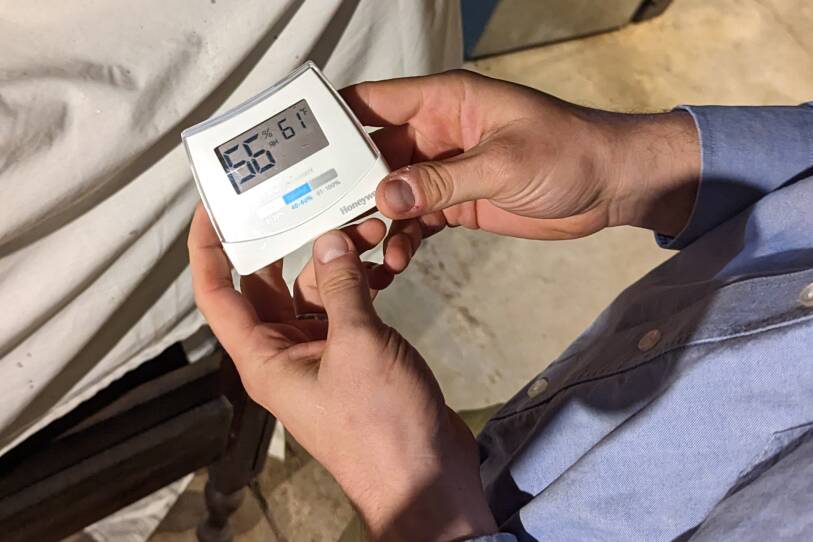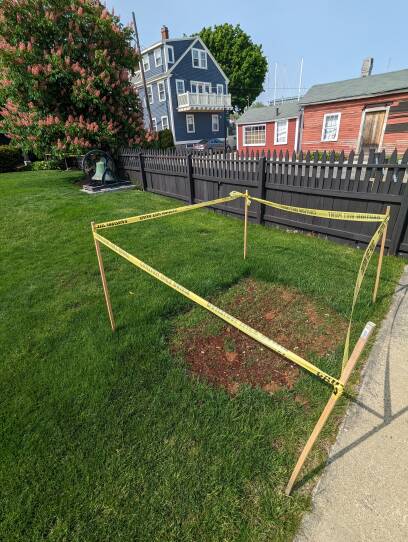Updated at 11:33 a.m. July 11
In the underbelly of the country's largest fieldstone basement, Paul Wright stooped low, dodging cobwebs to arrive at a relative humidity monitor — a small, thermostat-like device — perched on a wooden shelf. As he worked, the floors creaked above his head from the weight of literary nerds and vacationing families there to catch a glimpse of colonial life.
“Halfway down a bystreet of one of our New England towns stands a rusty wooden house, with seven acutely peaked gables,” wrote Nathaniel Hawthorne in his 1851 novel "The House of the Seven Gables."
Hawthorne’s book about a cursed family and their house was fictional. But the mansion itself is a real structure, resting on the edge of Salem.
This 355-year-old house looks well preserved from the outside: its slate-black paint looks new, complemented by a manicured trellis and a gravel garden path lined with flowers. Yet Wright, the historic site's preservation manager, is acutely aware of the myriad ways climate change is threatening the integrity of this structure — and because of the site's historic status, protecting it is a unique challenge.

Hotter days and heavier rains, along with the humidity and flooding they cause, create optimal conditions for rot and mold to eat away at this historic building.
The museum is now wrestling with the question: How much historical accuracy are they willing to sacrifice? In search of an answer to that very question, the House of the Seven Gables recently became the first historical site in the state to receive a grant to assess the threats of climate change and possible mitigation strategies.
The old foundation is constructed of fieldstone, a porous brown rock early colonists were eager to remove from their topsoil. Over the centuries, water has seeped through the fieldstone and the lime mortar piecing it together. That moisture might not have been a problem for Salem’s early settlers, who used their basements simply for storage. But it poses a bigger headache for buildings today that use such space for mechanical systems.

On the day of our visit, the relative humidity monitor showed a reading of 56%.
“We've had a dry stretch,” said Wright. “If we get a rain storm, the humidity shoots up to above 60, almost 70% pretty quickly.”
The ideal range is below 50%, he said. That's the level necessary to prevent mold and mildew from growing on the historical collections stored in the basement, and to protect the building's HVAC and electrical systems that support modern-day tourism and community activities.
The museum uses gutters and drains to keep as much water away from the building as possible — but that system only goes so far. There are more modern solutions to keep water out of basements. But, Wright says, those options would only work “if we were not a historic site, were not beholden to any rules."
The Seven Gables property has what’s called a preservation easement. The Massachusetts Historical Commission holds part of the deed to the land, so the museum must preserve buildings according to the state standards. In return, the Historical Commission gives the Seven Gables Settlement Association funds for preservation projects.
In addition, as a National Historic Landmark District, the property is confined by preservation standards set by the federal government and the town of Salem.
Because of these designations, unlike making renovations to a modern home, every nail and physical alteration at the Seven Gables must be approved by multiple stakeholders to ensure that historical accuracy is maintained.

Water, water everywhere
When the House of the Seven Gables was built in 1668, Salem Harbor would have been full of clipper ships bringing goods from across the world. Wright said he cannot confirm when the sea wall was built, but based on historical blueprints of the site he knows that some sort of wall has been in that spot since the early 1700s. That wall, which is the property's first line of storm defense, is only about 80 feet from the house.
Water flows over the wall during large storms, which are expected to become more frequent because of climate change. According to the state flood projections, in 50 years, the sea wall and some of the museum’s historic buildings — about a third of the property — could see up to 3.5 feet of flooding during storms.
Yet even on a daily basis, the sea wall must withstand the tides fluctuating about 5 to 10 feet. This tidal cycle has gradually pulled away sediment from around the sea wall and behind it. In 2019, that erosion became immediately apparent when a sinkhole opened on the Gables' lawn and swallowed a guest up to their knees .
In the short term, the Seven Gables can strengthen the wall by replacing missing stones, adding more mortar and filling in the empty space with new soil.
Long term, Seven Gables could raise the height of the sea wall to keep floods and high tides out. But the Gables cannot raise their wall alone; they are surrounded by other sea walls owned by the city and private property owners, and they’ve yet to collaborate on strategy, Wright said. Also, there's no preservation standards for sea walls, so the Seven Gables could be setting a precedent with such action. Kelleher said neighbors are interested to see how the museum proceeds and learn from its efforts.
It’s clear that sea level rise will have an impact. What’s less noticeable is the rising groundwater beneath the property.
Normally, groundwater flows downhill and discharges at the coast. But as sea levels rise, inland groundwater is pushed up to keep the same downhill flow toward the new coastline level. A 2020 study by researchers in California found that for every 3 feet of sea level rise, about a quarter of a mile more area of land will be flooded from below by their own water tables.
“You have surface flooding from the tide coming in over the land, and then you also have where the groundwater meets the tidal influence — and you have like a wedge there. And that's where it's pushing the groundwater up,” said Ellie Baker, an environmental planner at Horsley Witten Group, one of the engineering firms involved in the Seven Gables grant.
Seven Gables is already feeling this effect. In the basement of the house, some spots on the wooden floor are spongy. Wright said when the soil beneath the basement floor becomes damp, the wood rots and gives way.
Based on their calculations, the mean groundwater level and tide levels will increase on the museum property. And as the
frequency
of rainstorms and flooding is predicted to increase with climate change, the basement will have the added challenge of remaining dry from runoff that pools around the Seven Gables.
Balancing historical preservation and protection
While preservation guidelines remain, the Seven Gables property does have more flexibility thanks to recent changes at multiple levels of government in response to the growing threat of climate change.
The U.S. secretary of the interior’s flood protection guidelines — which Wright described as “the Bible for preservation” — were updated to keep up with increased flooding. The federal department will even now consider raising the foundations of historic buildings.
Locally, the Salem Historical Commission also recently updated its guidelines for historic buildings to address needs related to climate change, like adding gutters or replacing wood trim with synthetic material.
“It's a challenge,” said Patti Kelleher, the historic preservation planner for the city of Salem. “You're trying to preserve historic building fabric and architecture, while at the same time making it sustainable and resilient. It’s a delicate balance.”

Finding that balance between preservation and adaptation lies in understanding the actual risks facing the Seven Gables property, which is the goal of a roughly $510,000 grant from the Massachusetts Office of Coastal Zone Management.
“We're really trying to help the museum think through, you know, the next 30, 50, 70 years of preservation on the site,” said Baker, the Horsley Witten planner. “It's a matter of defining the triggers for making those changes.”
In November, Horsley Witten Group installed wells to measure groundwater and began collecting other data on the risks climate change poses to the building, while Collins Engineering examined the sea wall. Then, in April, the two engineering firms presented their initial findings to the Seven Gables and selected community members, including Salem's historic preservation planner, a city engineer and a representative from the National Park Service. Union Studio Architects, who are creating adaptation designs based off the engineers' data, also presented their findings.

Collins Engineering found voids extending 3 to 5 feet behind the wall, leading to all those sinkholes. They filled in some of these holes and, for the short term, suggested that the Seven Gables fill in remaining areas and add more mortar to the existing wall.
Data from the monitoring wells and tidal gauge found that the influence of daily tides on groundwater extends up to the visitor's center, leaving the Seven Gables' foundation, which is downhill, at the mercy of rising groundwater. The Seven Gables could install permeable pavement in the asphalt lot and brick walking paths to prevent water from quickly running downhill toward historic structures.
Over the next year of the project, data will continue to be collected and the community will be more involved as Seven Gables chooses its adaptation plans suggested by the engineers and architects. Then comes the next challenge: funding.
Flood-proofing a basement can cost several thousand dollars , and moving a building could be hundreds of thousands . And, Wright explained, every dollar spent on climate adaptation takes away from the House of the Seven Gables Settlement Association's mission to provide programs to immigrant families.
“I'm interested in hearing how a nonprofit organization could ever address those costs,” said Kelleher.
This is not a challenge unique to the Seven Gables. Private institutions and municipalities, like the Strawbery Banke Museum in Portsmouth, New Hampshire, and an entire neighborhood in Newport , Rhode Island, have had to find their own ways to fund climate adaptation projects.
The Strawbery Banke Museum has sought out sustainability-related partnerships and grants to support its efforts. Wright said he’s interested doing the same for the Seven Gables, which like the grant from the Massachusetts Office of Coastal Zone Management, would open up a new funding source for the museum.
The question is how to tell the House of the Seven Gables’ story for as long as the changing climate allows, and when to close the chapter on parts of that story when they can no longer be preserved.
“One way or another, something is going to give,” said Wright. “It's either going to be we're going to have to change our preservation practices of what is allowable, or we're going to have things taken by climate change.”
Clarification: This story was updated to clarify how sea level rise affects groundwater.





